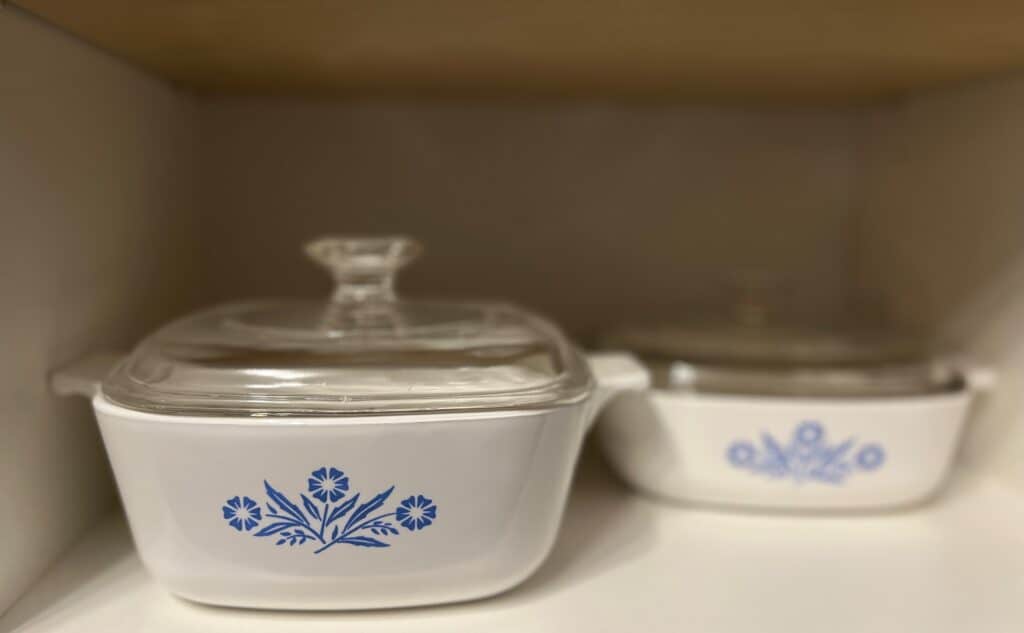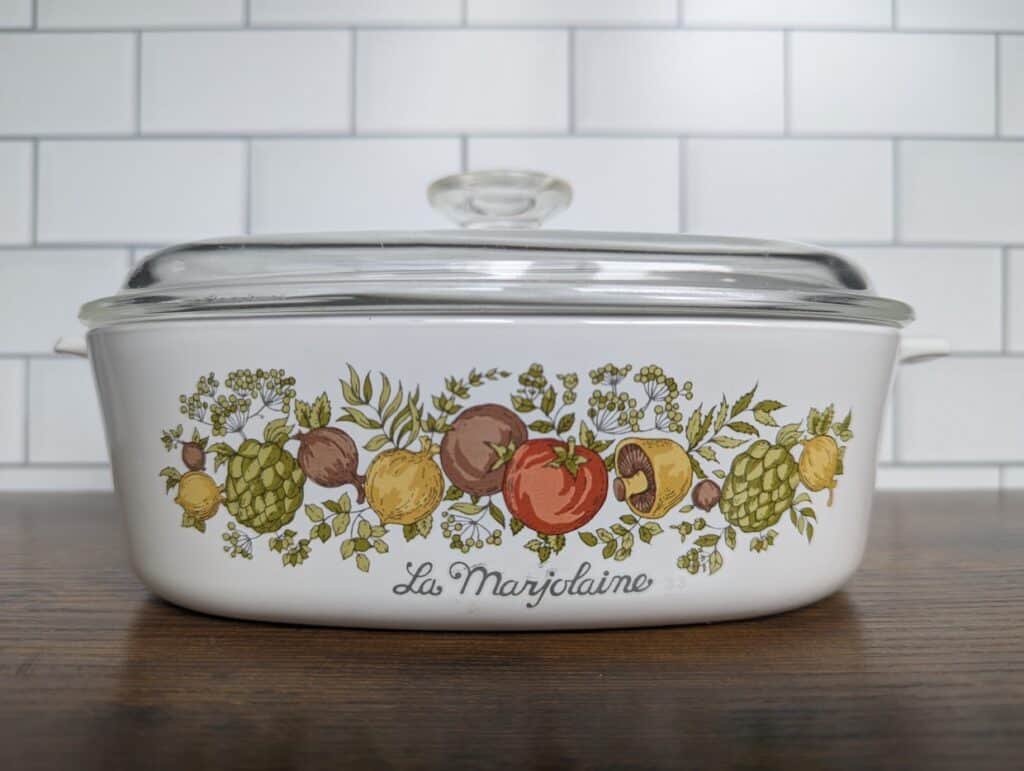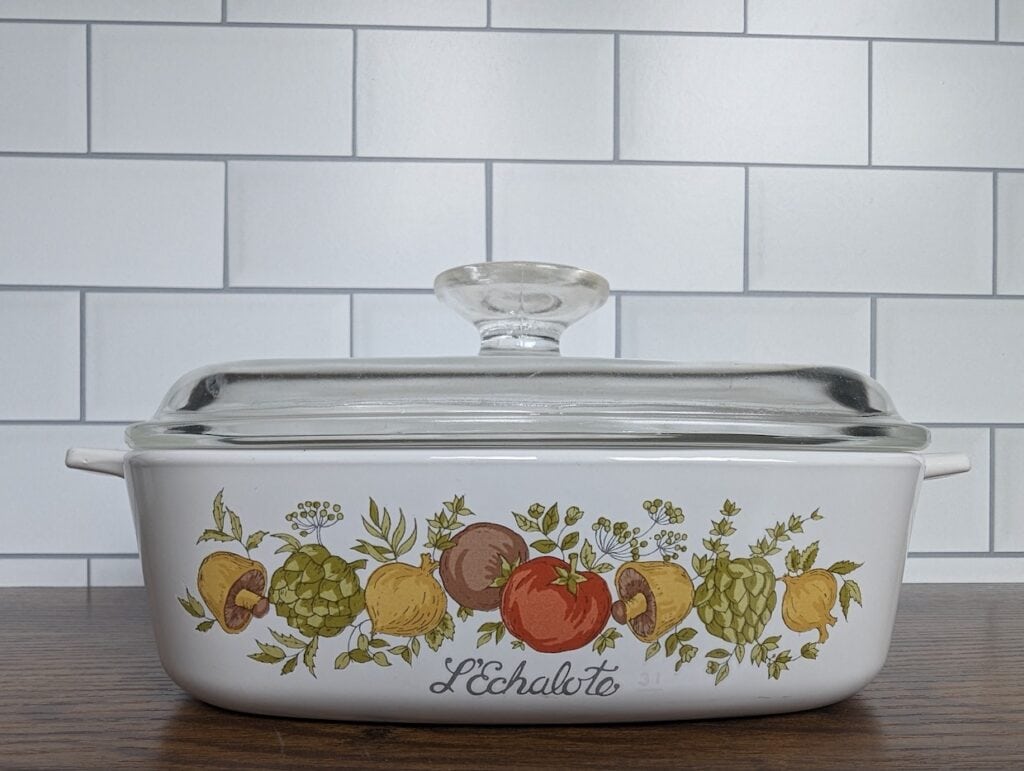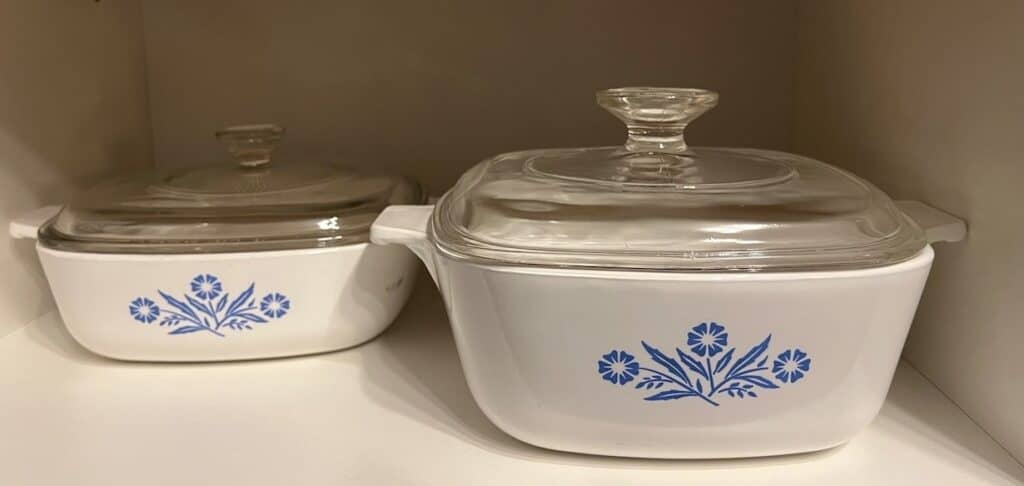Corningware, the casserole dishes and cookware from the 1970s and 1980s, has become highly desirable among collectors. Is it simply a case of everything old is new again or something else entirely? Read on to find out why vintage Corningware has become so popular lately.

Corningware’s novelty in the kitchen
Chances are your mother or grandmother cooked and served you a meal in one kind of Corningware dish or another. And it probably wasn’t such a big deal when the dish, with its signature blue flower insignia on the front, came out of the oven and onto the dinner table or into the refrigerator for leftovers.
However, before the invention of Corningware in 1957, the simple act of baking, serving and storing food in a ceramic dish was impossible. Remember: this was long before modern baking materials like silicone existed.
Shatterproof cookware
Most baking dishes would shatter when they had to go from one extreme temperature to another. So, if you had a leftover casserole in the freezer and you wanted to bake it for tonight’s dinner, you had to let it thaw, and the dish get to room temperature before putting it in the oven. Not so with Corningware, a glass-ceramic hybrid.
When the inventor of Corningware, S. Donald Stookey, first developed the material, he would take it out of a piping hot oven and then place ice cubes in it. It stayed solid. In fact, Stookey couldn’t break these dishes, even if he tried. When Stookey died in 2014, the New York Times obituary recounted him describing what happened when he dropped Corningware: “The thing bounced and didn’t break. It sounded like steel hitting the floor.“
Not surprisingly, the product tended to last for such a long time. So, even if a family member acquired it years ago, chances are those Corningware pieces were still in such good condition that they could be handed down from generation to generation. No need to cash in on the product’s lifetime guarantee. Corningware literally lasts for decades.
This was the case with my grandmother’s Corningware, who handed it down to my mother. Then, when I moved out on my own, my mother gave it to me. Finally, after my youngest daughter graduated from college, she got the Corningware cookware. She is a member of Gen Z, which is even redefining Mother’s Day.
Millennials and Gen Z embrace anything vintage
It seems somewhat fitting that my Gen Z daughter is now the fourth generation owner of the family Corningware. Her generation, as well as Millennials, is driving the trend for acquiring and the popularity of this cookware. There are a couple of reasons why.
Those generations — the children of Boomers and GenX — are some of the biggest fans of thrift store shopping. They understand that buying used makes economic and ecological sense. As the old saying goes, they will inherit the earth, so they want to make sure it is as healthy as possible. That’s why they tend to reject fast fashion and go for sustainable fashion instead.
There is also the nostalgia factor. Folks in their 20s and 30s recall seeing Corningware when they were children. It brings them back to happier, simpler times, as it does for Heidi Bruaw, who writes the Real Life of Lulu blog. “I love vintage Corningware because it reminds me of my childhood and having big family meals around the table,” said Bruaw, whose blog focuses on vintage recipes and more.
Where to buy vintage Corningware

If you’re lucky enough still to have your grandparents around, then check with them about any Corningware they might still have. What better way to add to your collection than to get it for free like my daughter did.
When Bruaw is on the hunt for new Corningware pieces, she’ll visit flea markets and thrift stores. There are other places to look, too. This includes:
- Estate sales
- Yard or garage sales
- House of Worship rummage sales
Recently, I found a Corningware piece at my local Habitat for Humanity ReStore thrift store. I’ve also seen them at national thrift chains like Goodwill and Savers. However, it appears they are well aware of the popularity of this brand, based on the tag prices. It seems a bit much to pay $50 for a used baking dish at a thrift store.
Finally, you can find Corningware via online marketplaces as well. This includes Amazon, Facebook, Poshmark, OfferUp, Etsy and eBay.
What to look for when shopping for Corningware
If you decide to buy some of these vintage dishes, make sure you know what you’re looking for. For instance, the blue flower design on the front — technically the cornflower emblem — is one of the most recognizable symbols of Corningware. However, it’s not the only one.
According to the book Corning Pyroceram Cookware by Debbie Coe, a glassware expert, there are more than 60 Corningware patterns. Along with the cornflower design, you might find what collectors call the Spice of Life Corningware. It includes a line of multicolored vegetables — shallots, mushrooms, artichokes — and a French word for one of the vegetables it features. For example, one has L’Echalote underneath. In French, that means shallot.

The Henry Ford Museum in Michigan recently hosted an exhibit called Pyrex, Corningware and Corelle: Enduring Kitchen Icons from Corning. Along with traditional cookware dishes, it featured Corningware coffee carafes, teapots and serving platters, all of which had the traditional cornflower blue pattern.
The exhibit also included advertisements showing how Corningware dishes could be square, round or rectangular. It highlighted other vintage Corningware patterns, including one featuring irises and another called a pastel bouquet of flowers.
There are two other things to look for when shopping for this cookware. First, the crock itself should have intact handles on either side. They are made of the same material as the cookware. Secondly, there should be a clear glass top.

Final thoughts
While Corningware lives on today as a brand within the Corelle family, the baking dishes are all white. So, if you love that vintage look, you’ll definitely have to buy secondhand. Now that you know what to look for and where to go, your hunt for these sought-after dishes should be a little easier.
Leah Ingram handed down her grandmother’s vintage Corningware to her Gen Z daughter. She features updated takes on her grandmother’s recipes on her food blog Bagels and Lasagna.
I have vintage corning ware that I would love to sell for.
Aren’t you lucky! Hang on to it – it’s going to go up in price!